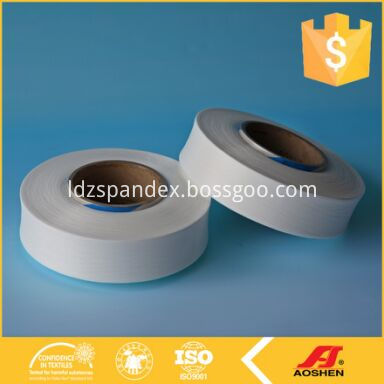High Load-power Spandex
With perfect elastic recovery, the resilience of fabrics with Aoshen® High Load-power Sapndex is improved by 20% compared with those under same draw-ratio. These series of products can be widely applied to the fabrics with high requirements on elasticity.
[Technical Superiority]
1. Big elastic elongation, high intensity and good recovering effect;
2. Fabrics produced by this series have fine wearing ability and durability;
3. The cloth surface is close-knit with heavy feeling.
[Specifications]
20Den
30Den
40Den
70Den
High Load Power Spandex, High Elastic Spandex,Elastic Waterproof Fabric Spandex,Polyester Print Fabric Spandex LDZ New Aoshen Spandex Co.,Ltd. , http://www.ldzspandex.com
Relative to the soaring prices of raw materials, the price increase for the end market is too long. As early as the end of last year at an industry conference, Yang Shibin, chairman of the China Knitting Industry Association, expressed confusion about the upside down prices of upstream and downstream products. He pointed out that the price of cotton has risen too fast, and the price of end products has not risen accordingly. He believes that there is no downstream transmission, and the high raw material prices will not support too long. This view of him is unanimously recognized by the industry, including the leadership of the China Cotton Textile Industry Association. Surprisingly, the price of cotton in the middle of the year has been staggeringly firm, and not only has it not fallen but has continued to rise.
Raw materials are just a bunch of heavier straws. This year's textile and garment companies have experienced more severe "labor shortages" and rising energy costs. Every time you participate in industry activities, "cost" is a topic that can not be bypassed. However, the external environment faced by export companies has made this situation worse. I remember when attending the China Textile and Apparel Trade Fair (New York) held in July this year, an exhibitor starkly said: "Now foreign companies are pushing down the price very much." If at that time, many export companies still reluctantly digested their own rise. The cost, and to the China Textile and Apparel Trade Fair (Paris) held in September, some exhibitors put forward the "we want to increase the price of foreign merchants" initiative until the November increase in prices became a reality.
The reason why the brewing for so long, the author believes that behind the show is the clothing company's helplessness and worries. As stated in the report on the economic performance of the knitting industry in the third quarter released last week, the rising costs and the appreciation of the renminbi have now approached the limits of the enterprise's endurance. Will result in fewer orders. Although the export situation this year is far better than last year, the consumer demand in the developed countries is still shrinking, and it continues to tilt toward low-end products. At this time, the test of price increase is not difficult to predict.
The trend of order transfer has become more intense since 2008, and now it will be unavoidable. It is time to make a careful decision on the direction of textile and garment exports. Industrial restructuring, industry insight has called for many years, and now both the internal and external environment make this proposition become imminent. 


Chinese apparel export companies have finally paid off. At the just-concluded Canton Fair in autumn, the quotation for apparel export orders was generally increased by about 30% year-on-year, and the price increase for individual products was even as high as 40%. This is reasonable, but I believe that for many companies, the days after price increases are not easy. Rising or not rising is a problem.
November 15, 2018